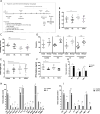Colon impairments and inflammation driven by an altered gut microbiota leads to social behavior deficits rescued by hyaluronic acid and celecoxib
- PMID: 38685001
- PMCID: PMC11059729
- DOI: 10.1186/s12916-024-03323-0
Colon impairments and inflammation driven by an altered gut microbiota leads to social behavior deficits rescued by hyaluronic acid and celecoxib
Abstract
Background: The exact mechanisms linking the gut microbiota and social behavior are still under investigation. We aimed to explore the role of the gut microbiota in shaping social behavior deficits using selectively bred mice possessing dominant (Dom) or submissive (Sub) behavior features. Sub mice exhibit asocial, depressive- and anxiety-like behaviors, as well as systemic inflammation, all of which are shaped by their impaired gut microbiota composition.
Methods: An age-dependent comparative analysis of the gut microbiota composition of Dom and Sub mice was performed using 16S rRNA sequencing, from early infancy to adulthood. Dom and Sub gastrointestinal (GI) tract anatomy, function, and immune profiling analyses were performed using histology, RT-PCR, flow cytometry, cytokine array, and dextran-FITC permeability assays. Short chain fatty acids (SCFA) levels in the colons of Dom and Sub mice were quantified using targeted metabolomics. To support our findings, adult Sub mice were orally treated with hyaluronic acid (HA) (30 mg/kg) or with the non-steroidal anti-inflammatory agent celecoxib (16 mg/kg).
Results: We demonstrate that from early infancy the Sub mouse gut microbiota lacks essential bacteria for immune maturation, including Lactobacillus and Bifidobacterium genera. Furthermore, from birth, Sub mice possess a thicker colon mucin layer, and from early adulthood, they exhibit shorter colonic length, altered colon integrity with increased gut permeability, reduced SCFA levels and decreased regulatory T-cells, compared to Dom mice. Therapeutic intervention in adult Sub mice treated with HA, celecoxib, or both agents, rescued Sub mice phenotypes. HA treatment reduced Sub mouse gut permeability, increased colon length, and improved mouse social behavior deficits. Treatment with celecoxib increased sociability, reduced depressive- and anxiety-like behaviors, and increased colon length, and a combined treatment resulted in similar effects as celecoxib administered as a single agent.
Conclusions: Overall, our data suggest that treating colon inflammation and decreasing gut permeability can restore gut physiology and prevent social deficits later in life. These findings provide critical insights into the importance of early life gut microbiota in shaping gut immunity, functionality, and social behavior, and may be beneficial for the development of future therapeutic strategies.
Keywords: Celecoxib; Colon inflammation; Colon mucin; Depressive-like behavior; Gut microbiota; Gut permeability; Hyaluronic acid; SCFAs; Social behavior; Tregs.
© 2024. The Author(s).
Conflict of interest statement
The authors declare that they have no competing interests.
Figures







Similar articles
-
Parthenolide ameliorates colon inflammation through regulating Treg/Th17 balance in a gut microbiota-dependent manner.Theranostics. 2020 Apr 6;10(12):5225-5241. doi: 10.7150/thno.43716. eCollection 2020. Theranostics. 2020. PMID: 32373209 Free PMC article.
-
Gut microbiota determines the social behavior of mice and induces metabolic and inflammatory changes in their adipose tissue.NPJ Biofilms Microbiomes. 2021 Mar 19;7(1):28. doi: 10.1038/s41522-021-00193-9. NPJ Biofilms Microbiomes. 2021. PMID: 33741982 Free PMC article.
-
Yanning Syrup ameliorates the lipopolysaccharide-induced inflammation: Adjusting the gut microbiota, short-chain fatty acids, and the CD4+ T cell balance.J Ethnopharmacol. 2022 Jan 30;283:114729. doi: 10.1016/j.jep.2021.114729. Epub 2021 Oct 8. J Ethnopharmacol. 2022. PMID: 34634365
-
Growing up in a Bubble: Using Germ-Free Animals to Assess the Influence of the Gut Microbiota on Brain and Behavior.Int J Neuropsychopharmacol. 2016 Aug 12;19(8):pyw020. doi: 10.1093/ijnp/pyw020. Print 2016 Aug. Int J Neuropsychopharmacol. 2016. PMID: 26912607 Free PMC article. Review.
-
Interplay between gut symbionts and behavioral variation in social insects.Curr Opin Insect Sci. 2024 Oct;65:101233. doi: 10.1016/j.cois.2024.101233. Epub 2024 Jul 15. Curr Opin Insect Sci. 2024. PMID: 39019113 Review.
Cited by
-
Prebiotic Activity of Acorus gramineus Rhizome Extract and Its Effects on Obesity and Gut Inflammation.Food Sci Nutr. 2025 Jan 30;13(2):e70020. doi: 10.1002/fsn3.70020. eCollection 2025 Feb. Food Sci Nutr. 2025. PMID: 39898126 Free PMC article.
-
Maternal oral sodium propionate supplementation restores gut integrity and mitigates stress-induced metabolic and behavioral outcomes in offspring.Transl Psychiatry. 2025 Jul 9;15(1):235. doi: 10.1038/s41398-025-03436-x. Transl Psychiatry. 2025. PMID: 40634281 Free PMC article.
-
Personality-based intergenerational effects of prenatal THC exposure in an inherited mouse model of social dominance and submissiveness.Sci Rep. 2025 Aug 20;15(1):30624. doi: 10.1038/s41598-025-15528-1. Sci Rep. 2025. PMID: 40835854 Free PMC article.
References
Publication types
MeSH terms
Substances
Grants and funding
LinkOut - more resources
Full Text Sources

